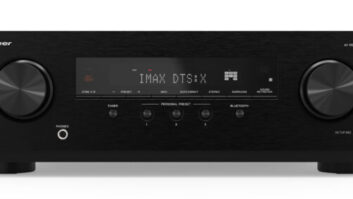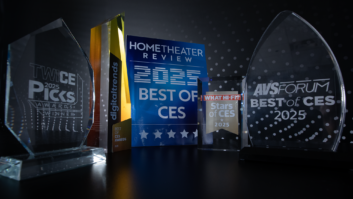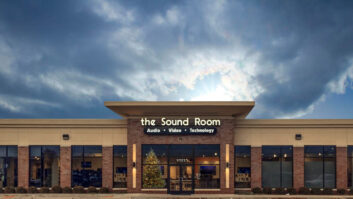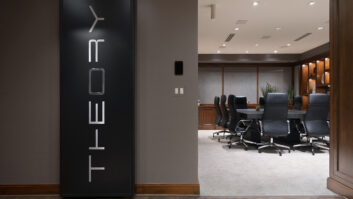NEW YORK – Traditional forms of audio components such as A/V receivers and passive speakers have begun to feel the impact of growing consumer demand for the convenience and simplicity of active soundbars.
Nonetheless, component audio could pick up again after a flat to down 2013 because of the transition to HDMI 2.0 connectors with HDCP 2.2 copy protection for copy-protected 4K content.
Wireless multi-room audio and high-resolution audio playback, though still in their infancy, will also help lift the home-audio market.
In other market changes, many audio suppliers are adjusting to the near-ubiquity of smartphones and tablets as music sources by launching Bluetooth speakers and networked wireless multi-room audio speakers, hoping to reach a generation that grew up listening to music through ear buds.
Active soundbars, meanwhile, are taking a toll on HTiB systems, compact 5.1 speaker packages, and entry-level A/V receivers, some suppliers say.
Those are some of the key takeaways from a questionnaire emailed by TWICE to key audio suppliers. Here’s what the panelists had to say:
COMPONENT-AUDIO OUTLOOK
TWICE: How did component audio sales (electronics and speakers) fare in 2013, and what’s the outlook for 2014?
Russ Johnston, Pioneer Americas marketing and corporate communications executive VP: In general terms, the electronics segment is flat with unit share shifts between manufacturers caused by yearto- year distribution changes. Additionally, the entrylevel receiver category has shown weakness due to the expansion of speaker bars. With all of that said, step-up receivers remain strong with growth due to multizone capabilities and built-in up-scaling.
Doug Henderson, B&W Group president: We have seen steady growth in 2013 as the macro-economic environment slowly improves. Many dealers are still challenged with weak floor traffic, however … The slow but increasingly steady rebound in the new-home construction market helps our custom installation products, around a quarter of our total business, and our dealers are focusing back on selling performance audio as a byproduct of price and profit compression elsewhere.
Mark Casavant, Klipsch Group global product development senior VP: We have experienced growth in component-audio sales. We have continued strength in our higher end component speaker business complemented with growth in integrated solutions such as soundbars. Demand is substantial for high-quality products, and consumers want the big sound to go with the big, beautiful flat screens so prevalent today …Consumers, however, want utter simplicity and ease of use, so we in the audio industry have to make these attractive products that deliver the powerful, motivating experience as well.
Robert Goedken, Yamaha Corp. of America A/V division general manager: Component-audio sales for the industry at retail were off slightly, 3 percent or so, but Yamaha was able to gain share and grew our business. We believe the stability of our brand and consumer-focus has helped us here. Our outlook for audio components in 2014 is up slightly due to three things. One, Ultra HD prices are coming down, and audio is important to the overall solution. As Ultra HD gains acceptance, consumers will need audio products that at least pass and potentially upscale to UHD, and all Yamaha AVRs have had this capability for several years. Second, HDMI 2.0 will be released later in the year, and we should see a lift in the higher end as consumers who have held off upgrading due to a new HDMI spec will enter the market. Third, we expect to continue increasing our market share.
TWICE: What component-audio segments are growing?
Johnston: We have seen strength at the $599 price point this year in A/V receivers. Consumers can get into a receiver that has 4K up-scaling, multizone and more than enough custom installation features for an installer.
Henderson: We only offer one AVR in our Rotel brand, and it is not a networked receiver. We have taken a direction where we let the dedicated network streamer brands do what they do best, and we add value through better audio circuitry, including DACs and amplification.
Both Rotel and Classe offer theater electronics, and we are seeing growth there as a function of the rebound in the dedicated theater business, an outgrowth of renewed new home construction, and also dealer focus.
Performance audio never went away, but it was diminished for several years with the growth of flat-panel television and control technologies that garnered much of the dealers’ attention, and of course the recession depressed business in all categories.
Casavant: Active soundbars are a key audio solution for many consumers who want to simplify their HDTV setup. Our goal has been to provide higherquality products to lure value-conscious customers into better performance. We are also focused on ASPs in every category that we participate in, and thus raising dealer revenue.
Active music systems are also a key product area for our portfolio. As more people want easy whole-house audio, it is in our wheelhouse to not only provide a full assortment of architectural custom-install products but also premium wireless, self-powered audio products of superlative quality.
Goedkin: Network AVRs are growing. Two-channel is stable. We see more products with streaming capabilities in most product categories growing. Soundbars continue to grow dramatically, and average selling prices are trending up.
TWICE:What features were in demand in receivers in 2013 and will be in 2014?
Johnson: By far, next-generation HDMI connectivity (HDMI 2.0) will impact multichannel receivers in 2014. And every time there are enhancements to connectivity, it stimulates receiver sales. Retailers find it very easy to add a receiver to a TV sale when there is an upgrade in connectivity technology.
MHL should also have a significant role in growth as connected streaming devices become more mainstream next year. One example is the Roku stick in which MHL will not only provide power but also control capabilities via the receiver remote.
Dannie Lau, DTS Play-Fi division general manager: 2013 saw an uptick in the number of network-connected AVRs. Music services, DLNA, AirPlay and just a general overall shift to music playback from mobile devices drove that shift. For 2014, we’re seeing increasing demand for Wi-Fi-based streaming technologies that can provide better compatibility with phones, tablets, and music services and that feature multi-room, multizone streaming. Multi-room, multizone streaming is nothing new to the AVR industry. High-end AVRs feature hardware-based audio mixes and dedicated channels of amplification for additional wired zones in the home. With wireless technology like DTS’s Play-Fi, these features can come down to mainstream price points without additional hardware costs or complicated wired installations.
Goedkin: Network, Bluetooth, music-streaming services led the feature demand in price points below $599, along with simplified app control. Above $599, overall sound quality, build quality and controllability led the way in feature-demand for A/V receivers in 2013. For 2014 we see continued consumer demand for networked products and streaming services, along with a greater focus on audio quality, driven somewhat by media awareness that consumers want higher-quality sound.
HDMI 2.0 will certainly enter the A/V receiver market. We see the HDCP 2.2 standard being driven more by the content providers than the hardware manufacturers, but it is important.
TWICE: What new features do you see coming to receivers in 2014 or expect to proliferate? Perhaps Dolby Atmos or DTS’s Multi-Dimensional Audio (MDA) multichannel-audio formats?
Henderson: These new surround technologies will not appear in our products in 2014. In general, it’s very clear that the consumer has generally rejected more than 5.1-based systems except in the dedicated theaters, and even there 7.1 seems to be more than sufficient to deliver a fully immersive experience.
Goedkin: There are expectations for these technologies to be in the marketplace, but the consumers who will be driven to purchase this technology are mostly the A/V or movie enthusiast, so it will likely get some interest, but will live mostly at the high end.
TWICE: Will the audio industry’s drive to promote high-resolution audio make any sales headway in 2014?
Johnston: High-res downloads are growing at impressive rates. At Pioneer, we offer every high-res audio decoder format built into our A/V receivers and stand-alone media players.
Henderson: Yes, but slowly. Unfortunately, it still isn’t easy enough for mass consumer acceptance to download and play high-resolution files, and although high-resolution Blu-ray audio discs are available, they remain well out of the mainstream. We are hopeful that both situations will get better steadily over time.
Goedkin: Research has shown that consumers claim to want better audio. So far, attempts to get consumers to act on that desire haven’t been very successful. With additional industry attention to better audio, we believe we will make some headway, but it will be slow.
SOUNDBAR OUTLOOK
TWICE:How much are active soundbars growing and why?
Johnston: We are looking for continued growth in the category from an industry perspective and are experiencing it first hand with our latest introduction into the category.
Henderson: Like the headphone pace, the soundbar market is becoming saturated, and this inevitably leads to consumer confusion and price compression. We had big growth prior to2013, but 2013 leveled off, and we expect about the same in 2014.
Casavant: Soundbars are a growing category, but ASPs are declining. Our soundbars continue to evolve, and the key to our success is delivering ease of use, simplicity and great audio performance. While customers want easy integration into their home space, they also want access to their mobile entertainment. As a result, we are providing the highest quality in wireless connectivity. For example, our Jamo Torsten soundbar comes complete with AptX Bluetooth connectivity for PCs, smartphones and tablets with amazing sound quality.
Goedkin: Soundbars continue to grow significantly. Growth may have come down a little in 2013, but the outlook on the industry in 2014 is still very good. The basic drivers for soundbar sales are poor TV sound and the acceptance of the ease of use and the simplicity of design.
TWICE: What active-soundbar features are most in demand?
Johnston: Wireless connectivity is definitely the category trend for the future. Our focus has been to bring our “Andrew Jones sound” into a category that was traditionally only slightly better than the original TV sound.
Henderson: Given the broad price spectrum available in the category, there is everything from very simple 2.0 systems that let the TV do the switching to more evolved models that offer full HDMI switching and provide Dolby Digital and DTS decoding. As a premium brand, our soundbar is a surround-sound solution for starters with an eight-driver array providing 5.1 playback and DD and DTS via HDMI. Network connectivity is best left to dedicated devices, like Apple TV, that can also supply video content. Bluetooth connectivity is becoming more popular as a simple streaming technology, but we don’t offer that today.
Casavant: Clarity in sound reproduction. There is little point in buying a soundbar if it doesn’t dramatically improve the TV’s sound, and dialog intelligibility in particular … Soundbar products are then also expected to deliver a hometheater experience, albeit in a simpler package than a multichannel system.
Goedkin: Bluetooth is a leading growth factor for active soundbars. HDMI is important for some customers, but we found that many customers are looking for a simple connection, so it is not really a must-have feature for everyone. Network connectivity and music streaming from the Internet is less important on a soundbar since it is found on many smart TVs already. We don’t see a trend with Dolby Digital or DTS decoding.
TWICE:At what point do active soundbars shift from being TV-sound enhancements to replacements for home-theater systems such as HTiBs?
Johnston: This phenomenon has already taken place and will continue to pressure HTiB’s future. More simplistic system configuration and aesthetic value have driven consumers to the soundbar category.
Goedkin: Yamaha’s YSP technology offers true surround sound from a single component soundbar, and it is the only product in the industry that can do this. The entry price point for this unique YSP technology is $449 MSRP and it tops out at $1,899 MSRP. Many consumers are using soundbars as HTiB replacements, but there is still a customer for the home-theater experience. Soundbar appears to be taking the HTiB customer, as HT continues at a fairly flat level.
HTIB OUTLOOK
TWICE:Are active soundbars competing with HTiBs?
Henderson: They can absolutely be a replacement for HTiBs, although a full 5.1 or 7.1 system will certainly offer a bigger, better experience. I think most people are migrating to soundbars as a function of the [TV’s] on-board sound having gotten so poor with the latest generation of super-thin TVs. Our customer for the Panorama 2, which at $1,799 is near the top of the active-soundbar category and offers a convincing surround experience, can certainly be a customer who in the past might have gone the separate-component route but is opting for simplicity or space savings. In other cases, this is a second (or third) system for a smaller room in a home with a dedicated theater system.
Casavant: For us, a compact 5.1 speaker package is a componentspeaker system that is easier to live with when space considerations come into play, like in a condo or apartment. These are high performance and approach the impact of a full-size multichannel speaker system. We need to remind consumers that a 5.1 package is an outstanding performance alternative and that soundbars are not in fact the “end all.”
Soundbars are affecting compact 5.1 speaker packages since they offer minimization of complexity and setup. Some consumers seem willing to sacrifice performance for the simplicity. Is it because they were not offered an alternative? As a manufacturer, we must consider the consumers’ experience and offer better high-performance products that still deliver simplicity.
Goedkin: Yes. Very much so. It has led to the substantial decline of all HTiBs. However, the HTiB category is still a large category and satisfies many consumers’ needs.
WIRELESS MULTI-ROOM AUDIO
TWICE: How well are wireless multiroom- audio systems doing in sales, and what’s the outlook for 2014 (including AirPlay speakers)?
Johnston: [Wireless] multi-room audio is definitely growing as a category but has not created mass appeal. Consumer confusion caused by inexpensive Bluetooth products has not allowed the industry to maximize the market. The premium for Wi-Fi technology and the lack of cash and carry/do-it-yourself systems are the barriers to growth. In time, consumers will grow to understand the convenience and improved sound quality of Wi-Fi-based networked systems.
Henderson: This is a very new category that is experiencing a lot of growth. We have seen tremendous growth in the category and now have four [Bowers & Wilkins] AirPlay speaker systems in our line from $399 to $799. The appeal is that people can use their iOS smart phone or other iOS device as a remote control for their iTunes library (using the Remote app) or a variety of other music streaming apps very easily with an active speaker. For the many people who have primarily used these devices for headphone listening, it is literally liberating the music from their head. We think that it is introducing or perhaps reintroducing people to listening to music in three-dimensional space, and a percentage will graduate to larger systems. We expect to see strong growth again in 2014.
Casavant: Wireless systems have typically depended on a home network. There are quality-of-service issues when a network feeds all multimedia devices in a home … Data-streaming buffers help, but a taxed home network can be a pain for the end user(s). One way Klipsch Group is countering this challenge is to offer direct wireless connection with our newest Klipsch Music Center Bluetooth wireless speakers as well as home Wi-Fi network connectivity.
Lau: Music consumption has transitioned to mobile devices, whether it be a PC, phone or tablet. We’re now seeing the effects of that transition with sales of wireless speakers growing at a near 200 percent year-over-year rate. Multi-room streaming is a natural extension to the category. As Bluetooth has become a commodity feature, multi-room streaming will lead the next growth phase. The use case for wireless multi-room audio is real, and when people are exposed to it, they have a gee-whiz moment, not unlike when VCR users had their first taste of TiVo. Brands like Sonos and B&W are already having success, and that success will spread in 2014 as more brands launch new products.
Noel Lee, Monster head monster: Multi-room wireless is the hottest category on the attachment/accessory side. We love it because it brings people back to real-life speakers, which have been a declining category. So speakers in any form are music to our ears, so to speak. When we started designing headphones, we were recreating the speaker experience, and now it’s amazing that after creating headphones that gave a real audiophile speaker-like experience – now people want to have speakers that sound like their headphones.
Multi-room wireless is what consumers want. Unfortunately, they don’t want Monster cables any more.
TWICE: Will the introduction of wireless multiroom audio systems from such big-name newcomers as Samsung and Bose accelerate growth?
Pioneer: The excitement from this category should attract all competitors and grow consumer awareness. Clearly, a robust, closed systems approach will be the key to winning in this category.
Henderson: These brands in particular, and many others, will increase awareness but also put pressure on the market to absorb the product.
Casavant: The expanding range with lower and higher price points sends a message to consumers that quality has a price, and in the case of Klipsch Group motivates us to bring higher performance to the category, as our dealers would expect. More brands entering the category is a positive development with reinforcements in retail merchandising, while it allows us to bring our performance formula to the table with the expectations inherent to our brands.
Lau: Yes. Clearly wireless is the future of audio, and manufacturers are hard at work revamping entire product lines of speakers, AVRs, HTiBs and soundbars. The entry of Samsung and Bose will certainly accelerate awareness of the category, as will new launches from other audio brands throughout the year. Interest will be a given, but a real concern is fragmentation. Are users willing to lock their purchasing decisions to single audio brand for the sake of multi-room? Or are users going to gravitate to multi-room streaming standards that are available across audio brands? We obviously think it’s going to be the latter, but as more choices become available next year, this will be a very real debate.
Another positive for the category is that wireless multi-room audio is being positioned as the next-big thing by retailers. You’ll see dedicated retail space for Wi-Fi audio products this holiday season, and that’ll continue to grow as new products are launched next year. The focus at retail will drive more brands into the category.
TWICE: What is the potential for floorstanding hi-fi speakers or bookshelf speakers to be equipped with amplifiers and network technology?
Johnston: We believe this market will remain with the audiophile and not expand into the mass due to the cost of technology and price points.
Casavant: As an advisory board member for WiSA, we are pursuing the integration of wireless into our best component speaker systems, such as Palladium. We will demonstrate this system at CES, but it combines the most desirable wireless functionality with the ultimate in floorstanding audio performance. We are also developing powered solutions for component speakers that allow easy access to content on mobile devices with Bluetooth AptX and self-powered speakers.
BLUETOOTH WAVE
TWICE: What are expectations for Bluetoothspeaker sales growth in 2014?
Toshihide Hokari, Imation product management and marketing executive director: The percentage of sales of Bluetooth-only speakers increased by triple digits in 2013. In 2014, Bluetooth-only speaker sales are expected to continue to grow but at a lower rate than in 2013. Products with flexibility in their power source (AC/DC) are likely to resonate better with consumers because the music source (smartphones) are also going anywhere and everywhere with their owners. Consumers have chosen to adopt Bluetooth technology for three primary reasons. First, because the Bluetooth technology allows them to keep the smartphones on them at all times. Second, Bluetooth technology works with most brands and is not hardwaredependent, and third, the overall experience, ease of use and audio quality continues to improve.
Casavant: Sales are strong for this speaker category, and the selection is growing. We view Bluetooth as the universal wireless solution, and it sounds better than ever, especially in our new generation AptXenabled products. Bluetooth is embedded in so many devices: notebook PCs, Android, Windows and Apple phones and tablets, etc., not to mention automobiles, new watches and fitness bracelets. And that’s the key to its success – consumers know it and see it reinforced in new products with new ways to utilize it to make life easier.
Lee: Monster was one of the first companies in Bluetooth speakers with our $99 ClarityHD that today continues to be one of our best sellers … So we started that craze, and now we have the MicroHD and something new that we’re announcing soon. The category has just exploded. However, I believe there are too many products, too many copy products, too many inferior products – everybody is trying to copy each other so very rarely is the quality even there.












